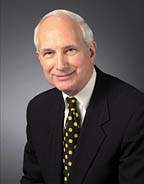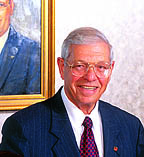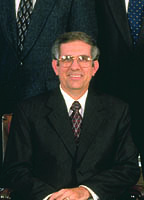Industry Advancement “Institutionalized”

In other words, NRCA really is the national association of roofing contractors.
When an association has been in business as long as NRCA, it can deliver many products and services to its industry and its membership. It also faces some unique challenges. An association can continuously point to its past accomplishments, but new members and those who would be members constantly ask, “What have you done for me lately?”
Beneath the umbrella of the NRCA organization is a separate but related organization known as the National Roofing Foundation (NRF). The NRF is a nonprofit, public foundation whose stated objectives are to “conduct research and educational projects that support high-quality programs for roofing contractors; ensure timely and forward-thinking industry responses to major economic and technological issues; and enhance the long-term viability and attractiveness of the industry to roofing workers.”
Operating within the NRF is a virtual powerhouse of contributing individuals and corporations banded together to institutionalize advancement of the roofing industry — The Roofing Industry Alliance for Progress. The “Alliance” has moved from an idea, to a group of key proponents, to a coalition of supporters who have now come up with an endowment sufficient to make a far-reaching and significant contribution to the advancement of the roofing industry in this country.
So where did the Alliance come from, and what has it done for us lately?

In The Beginning
To get the story of the beginnings of the Alliance, we spoke with Melvin Kruger, CEO of L.E. Schwartz & Son Inc., Macon, Ga. Among other life accomplishments too abundant to enumerate in a magazine article, Melvin Kruger is a past-president of NRCA. Kruger was there when the idea was first explored and advanced. He was one of the pioneers who took up the job of promoting the Alliance – after he himself first expressed doubts that the roofing industry would support a major foundation initiative. He says that at the time, “I did not have confidence. (A foundation such as the Alliance) was not part of our culture.” As it turns out, many have cited Kruger’s enthusiastic support of the Alliance as the reason they signed on as members and contributors.The story of how the Alliance came about began in 1995. According to Kruger, the NRF was originally driven by six to seven individuals that had managed to dispense with just around $30,000 to $40,000 in funding for educational projects. NRCA Executive Vice President Bill Good was dispatched to learn from his peers (other industry association executives) how they went about funding their foundations. Good found that many other industries had “substantial” foundations. Further study of NRCA members and associate members revealed there was a definite need for such a foundation.
A foundation consultant was retained, and he met with Kruger and Good. Kruger agreed to call a meeting of NRCA past presidents to consider the next steps. Seven of eight agreed to start the Alliance and personally call on 25 key roofing contractors to invite them to join the Alliance. Twenty-three of them said “yes.” Saying “yes” meant pledging $50,000 to the Alliance for a permanent seat as a “Charter Governor.” The group decided to raise the first $1 million from roofing contractors before approaching any other industry member. Once reaching this milestone, they went to the major manufacturers to solicit membership. The first major success came when Firestone gave the nod to a $1 million pledge.
The Alliance was founded on a number of principals (see “Mission Statement” inset), but some of those discussed in the beginning were at the heart of the movement. Kruger says the original vision was to establish the roofing industry’s reputation as an industry that cares and is involved. The Alliance is a marathon, not a sprint; it’s a long-term project. The basis for the Alliance is the pool of money that is set up as an endowment. The endowment (corpus) will remain intact and spending will be limited.
The Alliance Founding Governors (and other contributor-members) meet twice a year. Kruger makes note of many special, personal relationships that have developed as a part of the formation and work of the Alliance. He says, “The Alliance has taken on a life of its own.” As previously stated, the seats are permanent, and the contributing firms maintain the seats. There is an investment committee to oversee the endowment and a steering committee to study requests.
So what converted Kruger from skeptic to cheerleader? To begin with, this Alliance is about “continual improvement of the roofing industry.” Before the first meeting in 1995, Melvin Kruger had dedicated his professional life to that task. Education is a key element of this continual improvement process in the roofing industry, so how does Kruger feel about education? Here are just a few of his comments: “I think it’s the key to everything.” “It’s the greatest challenge for our country.” “Without education, young people become part of the problem.” And, Kruger says of the reason education is so important in his own firm, “We don’t have a job in our company that doesn’t require a person to read, write and work in a team environment.” All these things require education: basic elements to advance individuals and an industry.

The Alliance Today
At this point, cash and commitments to the endowment of the Alliance top $10 million. To learn more about the current activities of the Alliance, Roofing Contractor spoke with immediate past chairman Phil McKinney of Evans Service Company, Elmira, N.Y., and Christopher W. Seidel, executive director, NRF.The Alliance has funded several projects including: a national survey of roofing workers that provides an in-depth examination of employee satisfaction in the roofing industry; development of the NRCA Roof Application Training Program; a national public education campaign to familiarize students and workers with the roofing industry; a best-practices study of roofing contractors’ efforts to successfully recruit, train, and retain workers; a videotape program addressing roofing careers developed to recruit potential workers; and the “Most Valuable Player (MVP) Awards Program” to identify and honor outstanding roofing workers (up to and including foremen) from 10 regions in the nation.
One of the most ambitious Alliance initiatives is the NRCA Roof Application Training Program. The program is complete and is made available in modules specific to different types of roofing work. The modules address all aspects of roof installation, safety and quality of work, and include a multi-media approach with professionally produced videos as the centerpiece. Thanks to the efforts of the Alliance, roofing contractors now have available professionally produced, basic training modules that have historically been out of reach due to cost or lack of availability.
Unfortunately, the training modules have not been a commanding commercial success. Roofing contractors have not universally accepted the concept — either because they don’t know about it, or because they have not made the commitment to this kind of quality approach to education. Roofing Contractor spoke with one contractor who has made good use of the program, Larry Marshall of L. Marshall Roofing & Sheet Metal, Glenview, Ill. According to Marshall, “We have all the training modules here.” Marshall Roofing & Sheet Metal is mainly a commercial roofing contractor whose primary work includes historical renovation, architectural sheet metal, slate, tile, modified asphalt, BUR and coal tar systems.
Marshall Roofing & Sheet Metal uses the videos as part of its apprentice training programs and as a routine part of its scheduled safety meetings. Very pleased with the professional quality of the production, Marshall says, “We always have topics to talk about (at safety meetings)… but … what this has done … it has given the men a sense of importance … they are really part of a profession … it gives them a sense of pride.” A real key to the value of the videos is that they portray a model of a model roofing and sheet metal operation.
The Alliance Tomorrow
Well, that kind of depends on you and I, now doesn’t it? Certainly the least any of us in this industry can do is to support the Alliance by taking advantage of the educational opportunities they offer. It may be time for your firm to consider “stepping up” to the challenge of making a pledge to the endowment. Kruger says if there is a serious interest, an Alliance member will come over and visit with you personally to tell you all about it.In the final analysis, this is a long-term project. Kruger cites a number of reasons for the success of the founding of the Alliance, but the one theme that repeats is the relationships of the people involved and their commitment to the project. Kruger says, “People like to be part of something significant.” Make no mistake about it — the Roofing Industry Alliance for Progress is indeed significant.
Looking for a reprint of this article?
From high-res PDFs to custom plaques, order your copy today!



